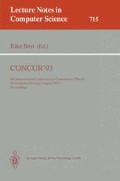Abstract
We give two fully abstract models for UNITY. The models are compositional with respect to the parallel composition of UNITY programs (that is, with respect to the UNITY union operator). One model is fully abstract for stutter-free execution sequences and the other model is fully abstract for several property models. The two fully abstract models are different since the model based on properties is more abstract than the sequences model. The fully abstract models yield the best refinement notions for programs that can be used for refinement in context.
This research has been supported by the Foundation for Computer Science in the Netherlands SION under project 612-317-107
Preview
Unable to display preview. Download preview PDF.
References
M. Abadi and L. Lamport. The existence of refinement mappings. In Proc. of the 3rd Annual IEEE Symp. on Logic in Computer Science, pages 165–175, Washington D.C., July 1988. Computer Society Press.
F.S. de Boer, J.N. Kok, C. Palamidessi, and J.J.M.M. Rutten. The failure of failures in a paradigm of asynchronous communication. In J.C.M. Baeten and J.F. Groote, editors, CONCUR '91, Proceedings of the 2nd International Conference on Concurrency Theory, volume 527 of Lecture Notes in Computer Science, pages 111–126. Springer-Verlag, August 1991.
K.M. Chandy and J. Misra. Parallel Program Design — A Foundation. Addison-Wesley Publishing Company, Inc., 1988.
E.W. Dijkstra and C.S. Schölten. Predicate Calculus and Program Semantics. Texts and Monographs in Computer Science. Springer-Verlag, Berlin, 1990.
J. Pachl. Three definitions of leads-to for UNITY. Notes on UNITY, 23–90, December 1990.
B.A. Sanders. Eliminating the substitution axiom from UNITY logic. Formal Aspects of Computing, 3(2):189–205, 1991.
R.T. Udink and J.N. Kok. On the relation between Unity properties and sequences of states. In J.W. de Bakker, W.-P. de Roever, and G. Rozenberg, editors, Semantics: Foundations and Applications, volume 666 of Lecture Notes in Computer Science, pages 594–608. REX Workshop, June 1992, Springer Verlag, 1993. A full version is available as Technical Report RUU-CS-93-07 of Utrecht University.
Author information
Authors and Affiliations
Editor information
Rights and permissions
Copyright information
© 1993 Springer-Verlag Berlin Heidelberg
About this paper
Cite this paper
Udink, R.T., Kok, J.N. (1993). Two fully abstract models for UNITY. In: Best, E. (eds) CONCUR'93. CONCUR 1993. Lecture Notes in Computer Science, vol 715. Springer, Berlin, Heidelberg. https://doi.org/10.1007/3-540-57208-2_24
Download citation
DOI: https://doi.org/10.1007/3-540-57208-2_24
Published:
Publisher Name: Springer, Berlin, Heidelberg
Print ISBN: 978-3-540-57208-4
Online ISBN: 978-3-540-47968-0
eBook Packages: Springer Book Archive

